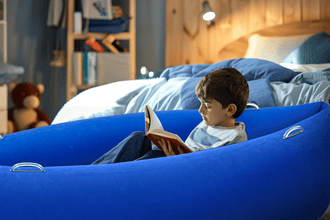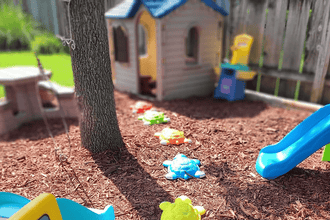
The Benefits of Sensory Swings
Introduction:
Have you ever watched a child on a swing, their face lit up with pure joy? It's more than just fun - it's a powerful tool for development. The benefits of sensory swings are gaining popularity among parents for their numerous advantages, and it's no wonder why. As an experienced child development specialist, I’m excited to share how these swings can transform your child’s growth and well-being.
Cognitive Benefits
1. Enhancing Brain Development
The movement activates different areas of the brain, encouraging neuroplasticity, which is the brain's capacity to reorganize itself by creating new neural connections. This is crucial for learning and adapting to new experiences.
I remember a parent sharing how her son, initially struggling with reading, showed significant improvement after a few months of using a sensory swing. The rhythmic motion helped him focus and calm down, making it easier for him to concentrate on his studies.
2. Improving Focus and Attention
Sensory swings are particularly effective at enhancing focus. The swinging motion provides a calming effect, which can help children concentrate better on tasks. This is especially beneficial for kids who find it hard to sit still.

3. Boosting Creativity and Imagination
The safe and calming atmosphere of a sensory swing can also enhance your child’s creativity. It provides a space where they can let their imagination run wild, whether they’re pretending to be an astronaut, a pirate, or just enjoying the ride. This imaginative play is essential for cognitive development and problem-solving skills.
Physical Benefits
1. Developing Motor Skills
Sensory swings are fantastic for developing both fine and gross motor skills. The act of swinging requires children to use their muscles to push and pull, enhancing their strength and coordination.
Take, for example, a little girl named Lily, who struggled with motor skills due to a developmental delay. Her occupational therapist recommended a sensory swing, and within weeks, her parents noticed a remarkable improvement in her coordination and strength.
2. Improving Balance and Coordination
Swinging provides excellent vestibular input, which is vital for balance and coordination. The back-and-forth motion helps children develop a sense of spatial orientation, making them more aware of their bodies and how they move.
Emotional and Behavioral Benefits
1. Calming Effects
If your child struggles with anxiety or frequent meltdowns, sensory swings can be a game-changer. The gentle motion has a calming effect, helping children manage stress and anxiety. I’ve seen firsthand how a sensory swing can turn a meltdown into a moment of peace.
2. Enhancing Emotional Regulation
Sensory swings also play a significant role in emotional regulation. They provide a safe space for children to understand and manage their emotions. For instance, when a child feels overwhelmed, a few minutes in the swing can help them regain their composure.
3. Reducing Behavioral Issues
Regular use of sensory swings can lead to fewer behavioral problems. The calming effect and emotional regulation benefits translate to better behavior overall. Parents often report a decrease in tantrums and an increase in cooperative behavior after incorporating sensory swings into their routine.

Benefits for Children with Special Needs
1. Autism Spectrum Disorder (ASD)
Children with Autism Spectrum Disorder (ASD) can particularly benefit from sensory swings. The swings provide the sensory input they often crave, helping them feel more grounded and focused.
2. ADHD
Sensory swings provide children with ADHD a secure way to channel their energy. The motion helps them channel their hyperactivity into something productive and calming. One parent told me about her son with ADHD who used to struggle with focusing on homework. After using a sensory swing regularly, he became more settled and able to concentrate better.
3. Sensory Processing Disorder (SPD)
Children with Sensory Processing Disorder (SPD) often have difficulty integrating sensory information. Sensory swings help by providing consistent and controlled sensory input, making it easier for these children to process and respond to their environment.
Practical Tips for Parents
1. Choosing the Right Sensory Swing
When choosing a sensory swing, take into account your child’s needs and the space you have available. There are various types of swings - from hammock-style to platform swings. Each type offers different benefits, so it’s essential to choose one that suits your child’s specific needs.
2. Setting Up a Sensory Swing at Home
Installing a sensory swing at home can be straightforward. Ensure you have a sturdy support structure, such as a beam or a strong ceiling mount. Safety is paramount, so follow the installation instructions carefully. If in doubt, consult a professional.
3. Incorporating Sensory Swing Time into Daily Routine
To maximize the benefits of sensory swings, make sensory swing sessions a regular part of your child’s routine. Start with short sessions and gradually increase the time as your child becomes more accustomed to it. You can incorporate the swing into playtime, relaxation periods, or even before bedtime to help your child wind down.

Conclusion
Recap of Key Benefits: sensory swings offer numerous advantages, from enhancing brain development and motor skills to providing emotional regulation and calming effects. For children with special needs, these swings can be especially transformative.
Encouragement for Parents: If you’re considering adding a sensory swing to your child’s environment, I wholeheartedly encourage you to do so. The benefits of sensory swings are profound, and the joy on your child’s face will be priceless.
Call to Action: Have you tried a sensory swing for your child? Share your experiences in the comments below!







